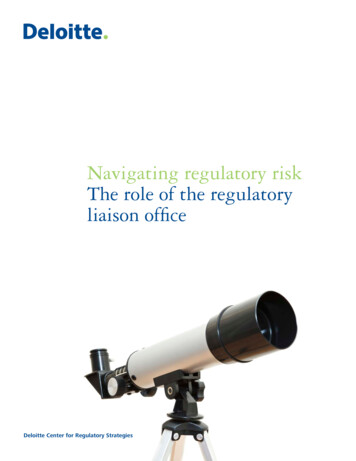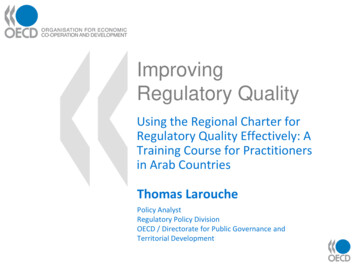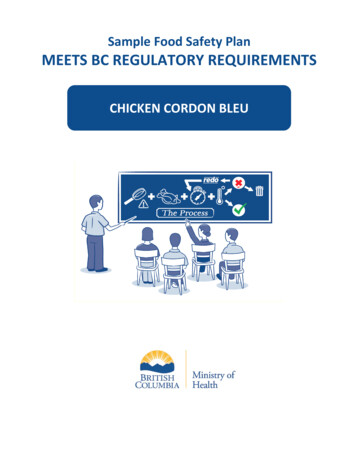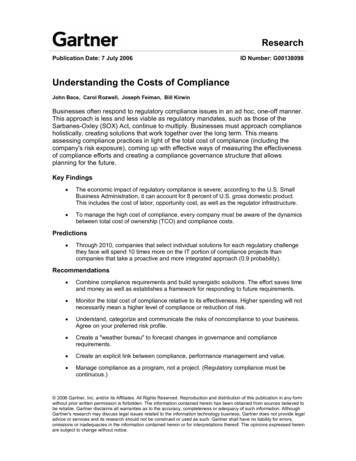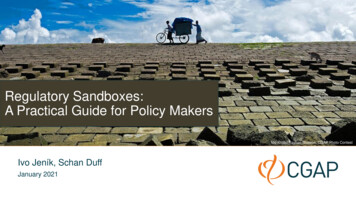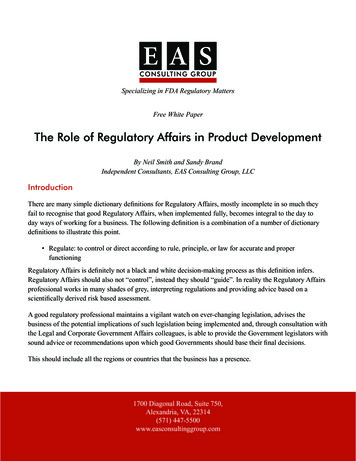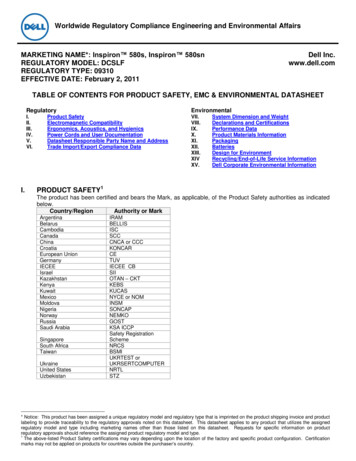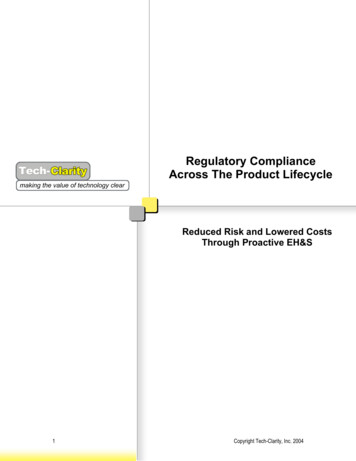
Transcription
Regulatory ComplianceAcross The Product LifecycleReduced Risk and Lowered CostsThrough Proactive EH&S1Copyright Tech-Clarity, Inc. 2004
Table of ContentsExecutive Overview . 3Compliance Is Critical to Sustained Product Value . 4Non-Compliance Surfaces at Inopportune Times . 7Moment of Regulatory Crisis– Found in Design. 7Moment of Regulatory Crisis– Found in Production. 8Moment of Regulatory Crisis– Found in Logistics . 9Moment of Regulatory Crisis– Found at Customer . 9Implementing Design for Compliance . 10Implementing Proactive Compliance Monitoring . 11Documenting Compliance. 12Recommendations . 14About the Author . 142Copyright Tech-Clarity, Inc. 2004
Executive OverviewThe value that Product Lifecycle Management (PLM) initiatives provide tomanufacturers comes in many forms, including: faster introduction of products, reducedproduct cost, increased product sales, higher product quality, reduced waste and morevaluable product portfolios. These are some of the more positive aspects of PLM thatpeople like to talk about. One area that doesn’t get as much attention is compliance.Regulatory compliance, while nobody would dispute the critical need for it, is not asexciting or enjoyable to discuss. The problem with leaving compliance unspoken is that asignificant amount of the value associated with Product Lifecycle Management isdependant on addressing compliance in a cost-effective manner. In fact, all of the benefitsof PLM could be quickly erased by significant non-compliance events that impact thecompany through fines, penalties, negative publicity or prohibition to sell a new productin key markets. Compliance risk may not be a glamorous topic, but it is critical to thedevelopment and sale of profitable products and responsible, sustainable corporateprofitability.All of the benefits of PLM could be quickly erased by significant noncompliance events that impact the company through fines, penalties, negativepublicity or prohibition to sell a new product in key marketsFew would disagree with placing compliance to regulations as a goal for a PLMinitiative, but at what level of priority? At what cost? For which jurisdictions? Withoutproactive management, regulatory problems are often found at the most inopportunetimes. This paper will review real examples of “moments of regulatory crisis”, theirimpact on the business, and the value that focusing on compliance throughout the life ofthe product can provide. Design for compliance and proactive monitoring can helpcompanies navigate the myriad of regulatory requirements required for profitablebusiness.3Copyright Tech-Clarity, Inc. 2004
Compliance Is Critical to Sustained Product ValueThroughout the product lifecycle companies must ensure that they remain in compliancewith governmental regulations and internal corporate guidelines. Without a compliancestrategy, the PLM value proposition is at risk. For example, companies have recognizedthe strategic value that getting products to market faster can offer. Accelerated time tomarket is a frequent goal that companies look for from better management of products,and companies have invested in compressing product development cycle times, supplychain efficiencies, more effective product commercialization and other methods to maketheir products available before their competition can react. Compliance is critical to timeto market. If compliance is not designed into the product from the very beginning, costlytime can be consumed redesigning or reformulating the product to address compliance. Acommon scenario for redesign occurs when expanding a product to a new market.Regulations can vary significantly based on where the product is being sold, based ondifferent regulatory bodies and jurisdictions. If a designer develops a product withoutvisibility to its eventual markets, restricted materials may be included in the product andforce significant design rework. These design flaws, if they are not caught early in theprocess, can cost companies significantly in time to market.Without a compliance strategy, the PLM value proposition is at riskMinimizing the cost of a formulation or design is another key benefit sought from PLMinitiatives. By actively managing both internal and supply chain costs in the productdesign phase, companies have been able to significantly reduce the cost of their products.This reduced cost provides benefits in increased margins or increased competitive pricingif the savings are passed along to the customers. Again, compliance is critical toachieving the benefits. If product designs are developed that violate regulatory rules, theproduct may have to be modified to comply after it has been released to the market.Alternatively, the design may result in significant additional cost to ensure compliance inthe form of additional pollution control equipment during manufacturing, protectivepackaging, rigid storage requirements, and specialized waste disposal. Once a product isreleased and in use by customers, the degree of flexibility that the designer has to makechanges is drastically reduced. The sooner that compliance issues are addressed, the moreoptions the designer can tap to keep product costs optimal. As time runs out, so dooptions, and the cost goes up. These costs are not limited to ingredient or componentcosts. Increased handling, transportation, manufacturing and regulatory fines are otherareas of cost that can quickly erase the value that least cost designs can provide.4Copyright Tech-Clarity, Inc. 2004
A final example of additional value of is improved value of product portfolios. Byincreasing the level of innovation within a company, and bringing more differentiatedproducts to market, companies can increase their value through improved products on themarket. Improved products increase sales and should lead to increased companyvaluations. But what value does a reputation for leading and innovative products standagainst an environmental or regulatory public relations crisis? In the same way that thenet present value of a new product idea is discounted by risk factors, perhaps companyvaluations should be discounted based on regulatory risk.Perhaps company valuations should be discounted based on regulatory riskFor most of the proven value that can be generated by an effective PLM program, there isrisk from non-compliance that can negate the benefits of PLM. While the benefit and thepotential risks are not always clearly related, the comparison of value to potentialdownfall serves the purpose of highlighting the need for regulatory compliance within aPLM strategy. Companies that invest in PLM and ignore compliance issues may begetting their product development house in order, but it may turn out to be a house ofcards if there is not a solid foundation that minimizes the risk of non-compliance.5Copyright Tech-Clarity, Inc. 2004
PLM BenefitImprove Time to MarketConsequence of NoncomplianceProduct Introduction DelaysDesign Rework for ComplianceDelayed Rollout to GeographiesReduce Product CostLast Minute Design ChangesNeed to De-Optimize DesignsFines and PenaltiesUnforeseen Supply Chain CostsManufacturing Process ChangesUnidentified Pollution and Exposure ControlReduce Development CostDesign ReworkManual Creation of DocumentationManual Effort to Catch FlawsIncrease Value of ProductPortfolioLimited Markets for ProductsProduct Value Discounted for RiskCompany Value Discounted for RiskNegative Public PerceptionCriminal ProsecutionCompany Not Seen as a “Green” CompanyImproved InnovationLast Minute Design ConstraintsProduct Delays or CancellationsIncreases Success Rate of NewProduct Development ProjectsMissed Window of OpportunityProducts Not Valid for GeographiesProduct Registration and LimitationUnforeseen Pollution Control IssuesImprove Handoff From R&D toManufacturing / OutsourcedProductionLast Minute Labeling ProblemsLast Minutes Repacking ProblemsUnidentified Health RisksUnidentified Safety RisksDelays for Regulatory DocumentationDelays and Extra Costs for TransportationRight to Know Requirements not MetGeneral Compliance Documentation issuesIncrease Product QualityProduct Performance Reduction from ChangesTable 1: Consequence of Noncompliance on PLM ValueSource: Tech-Clarity6Copyright Tech-Clarity, Inc. 2004
Non-Compliance Surfaces at Inopportune TimesCompliance is not coincidental. It requires knowledge of the applicable rules andregulations and adherence to those constraints throughout the design and production ofthe product. Compliance starts with a core of knowledge, and stretches throughout thelifecycle of the product. Failure to focus on addressing regulatory requirements can leadto regulatory design flaws. Regulatory design flaws, when discovered in the design phaseof a product, are typically easy to correct. The later a problem is found, however, themore costly it will be to address. When design flaws surface at inopportune times,particularly when the product has been sold and delivered, the flaws can escalate into“Moments of Regulatory Crisis”. Moments of Regulatory Crisis are points in time wherepast inattention to compliance issues become critical, and sometimes public, problems.The following examples highlight the impact of non-compliance, how easy the flaws areto create, and how they can be avoided.Moments of Regulatory Crisis are points in time where past inattention tocompliance issues become critical, and sometimes public, problemsMoment of Regulatory Crisis– Found in DesignWe’ll start with a positive example. This moment of regulatory crisis is, in fact, not acrisis but a nuisance. Before a product has been released to manufacturing and deliveredto a customer, the R&D team has more flexibility to make changes.During the design phase it becomes clear that a new product, perhaps a reagent formedical diagnostic equipment, is not only an excellent product for the US market but alsofor the European market. The marketing managers state that this product will have a highsales potential in Europe. The problem, however, is that one of the components in theformula is not listed on the European Inventory of Existing and New ChemicalSubstances (EINECS/ELINCS). There are several approaches to overcome this: 7Notification of the chemical in Europe. This requires extra testing andnotification, which may take more than half a yearSubstitute another chemical with similar properties, and try to correct for anyresulting change in performance of the productMake two similar products, one for the US and one for EuropeCopyright Tech-Clarity, Inc. 2004
If this type of problem is found during the design phase, as in this example, the potentialresolutions can be reviewed and selected proactively before the product is released to theUS market. If the product had been released without the component being flagged, or ifthe potential for the product to be sold in Europe is not identified in advance, the optionsfor resolving the problem would have been more limited.If a problem is found during the design phase, the potential resolutions can bereviewed and selected proactively before the product is releasedMoment of Regulatory Crisis– Found in ProductionThe next regulatory crisis is an internal issue, one that causes internal delays, disruptionand expense. A new product was scheduled for production that had been successfullypiloted and run in R&D but was not yet in full production at the plant. During theproduction planning process, a routine check discovered that this product with highexpectations for the Italian market contained a new solvent, gamma-butyrolactone(GLB). GLB is on the Italian List of Substances considered as “Drugs”. Due to thisdecision, the use of GLB has to be authorized for this product. This means an uncertainty(will the authorization be given?) and at least a delay of several months before theproduct can be put into production.If this type of problem is found in production, the options for recovery are morelimited and the potential impact of the problem is greaterIf this type of problem is found in production, the options for recovery are more limitedand the potential impact of the problem is greater. The resulting change in the productionschedule will likely add unnecessary cost, and the product that is not produced was likelydestined for delivery to a customer that now must be disappointed. Had this problem beendiscovered in the design phase, the impact would have been much lower.8Copyright Tech-Clarity, Inc. 2004
Moment of Regulatory Crisis– Found in LogisticsAnother area where surprises can occur is in logistics and transportation. Hazardousmaterials require documentation, placarding and labeling specific to not only the productbut also to the transportation mode. This example identifies the challenges that can occurafter the product is in production, challenges that can substantially increase costs ordecrease product reach. A company was changing shipping modes for a product whenthey discovered that the product was prohibitively expensive to ship in the preferred waybecause of its physical properties.The recently adopted Amendment 31-02 of the International Maritime Dangerous GoodsCode (IMDG) has put more severe rules on the segregation of alkalis and acids. Based onthe IMDG, a product that contains both a bottle with an alkali and a bottle with an acid inthe same box are no longer allowed to be shipped by sea. The product, perhaps a test kit,must be redesigned to ship in separate boxes of the alkali and the acid, to be shipped onseparate pallets.If manual processes are required to review every potential impact of aregulatory change, it is likely that some problem will be overlooked and thedisruption will impact the customer as wellThis example, which occurred after the product was released, caused a lot of disruptionfor the manufacturer and for their customers. If the problem was caught earlier, theproduct might have been able to be redesigned before the new regulation went into effect.If manual processes are required to review every potential impact of a regulatory change,it is likely that some problem will be overlooked and the disruption will impact thecustomer as well.Moment of Regulatory Crisis– Found at CustomerAccording to California Proposition 65 even traces of Dioxane contained in a printing ink(as an impurity in one of the raw materials) make it necessary to put the name of thischemical on the label when sold in California. This printing ink is sold world-wide withonly one label which discloses the traces of Dioxane. A customer in Australia discoversthat the printing ink contains Dioxane and thinks his health is in danger because of theuse of this ink. He sends letters to the trade magazines of his “discovery”, resulting in adamage of the good name of the company. As for almost the rest of the world there areno legal obligations to put the name Dioxane on the label or even disclose it in a SafetyData Sheet, the company could have mentioned this name only on products sold in theState of California.9Copyright Tech-Clarity, Inc. 2004
This example highlights the fact that manufacturers must manage regulatory andcompliance requirements across geographies and jurisdictions. By designing the labelingfor the most restrictive jurisdiction, the company simplified the management of theirlabeling, but created a potential problem. The alternative, which requires a greater levelof coordination and control, is to develop alternative labeling or recipes to meet differentregulatory goals. With accurate, detailed information of requirements by geography thecompany can better analyze the available options and then implement them effectively.Manufacturers must manage regulatory and compliance requirements acrossgeographies and jurisdictionsImplementing Design for ComplianceExperience shows us that driving flaws out of processes drives greater quality. Thisconcept is the foundation for many quality programs including Total QualityManagement (TQM), Six Sigma and others. In the same way, the process of productdesign can be improved to prevent moments of regulatory crisis. A moment of regulatorycrisis should be considered a flaw in the design process, whether the problem occurs inthe physical or commercial aspects of the design. Compliance must be considered acritical outcome of the design process. In order to achieve this, regulatory requirementsmust be identified and addressed early in the process. For companies that have adopted agated product development process, compliance should be included in all stages. Thisincludes the very beginning stages of design, before any resources from R&D may beinvolved. A thorough review of the markets for the product should identify the intendeduse of the product as well as the geographies in which it will be sold. These are criticaldesign constraints for the designers.A moment of regulatory crisis should be considered a flaw in the design process,whether the problem occurs in the physical or commercial aspects of the designWhen designers have all of the appropriate constraints in hand, the next challenge is toensure that they have the tools available to identify violations to these constraints. Thetangle of requirements is far too complex and changes too rapidly for any person to hopeto address without automation. Designers should have access to tools that canautomatically interrogate their designs and flag potential regulatory issues early in thedesign process. The ideal scenario would include the ability to instantly view the resultsthat the design would have on product labeling, transportation and compliance issues.10Copyright Tech-Clarity, Inc. 2004
To effectively and efficiently manage regulatory and compliance issues requires a toolthat can manage the complexity for the designer, but also a trusted source of updatedregulatory information that is integrated into the tool in the form of rules. Although somecompanies attempt to develop these systems on their own, packaged solutions andservices are available. “Creating a Material Compliance System from the ground up canbe a labor intensive and time consuming endeavor that typically yields a solution thatdoes not address global legislation and is expensive to maintain” says John Phyper,coauthor of Global Materials Compliance Handbook (Phyper, Ducas, Baish – Wiley2003) and COO at material compliance software provider Atrion International, “and ifnot designed and implemented properly, the system may lack key integration points toother major systems within the organization, only address a small portion of relevantlegislation, and become outdated within a relatively short period of time.” Based on thislevel of complexity and the dynamic nature of regulations, the regulatory information andtool are both good candidates to be outsourced to take advantage of industry-leveleconomies of scale. In this way, individual companies don’t have to proactively monitorfor new and changing regulations.“Creating a Material Compliance System from the ground up can be a laborintensive and time consuming endeavor that typically yields a solution that doesnot address global legislation and is expensive to maintain” says John Phyper,coauthor of Global Materials Compliance Handbook and COO at materialcompliance software provider Atrion InternationalImplementing Proactive Compliance MonitoringThe compliance checks in the design phase are critical to developing designs that meetcurrent regulatory demands. Unfortunately, the regulatory environment is a movingtarget. Rules and regulations are in a constant state of flux and revision, and can impact aproduct anywhere along its lifecycle. Recent regulations, in fact, have begun to placeeven higher emphasis on the environmental impact of the product upon disposal orrecycling. Changing regulations, including trade regulations, must be proactivelyidentified and compared to existing (and sometimes previous) product designs in order totrap potential compliance events. Diagram 1 below, reprinted with permission fromAtrion International, provides an excellent overview of the areas that require attentionfrom Proactive Compliance Monitoring:11Copyright Tech-Clarity, Inc. 2004
Diagram 1: Managing Compliance in the Product LifecycleSource: Atrion International (www.atrionintl.com)Documenting ComplianceCompliance must not only be implemented across the product lifecycle, it often must beproven. Documentation of compliance is an important aspect of compliance itself. Thecompany should have access to all regulatory rules as well as the proof that they arebeing adhered to. This reporting must be based on a solid foundation of productknowledge that identifies the specifications and composition of the compliant materials.Standard regulatory reports, as well as ad-hoc analysis required to identify potentialfuture problems, should be readily available. As regulations change, reports should beprepared that display all raw materials and all products that would not be in compliance.Because most regulations have a timeframe identified for compliance, the report can begenerated to allow the maximum possible lead-time to address the issues so that optimaldesign choices can be made instead of last minute temporary fixes with negativeconsequences like increased product cost. Whether standard or ad-hoc, documentation ofcompliance shows that the process is in control, and can be as important in many cases ascompliance itself.12Copyright Tech-Clarity, Inc. 2004
In many cases, the documentation is the source of compliance. Hazardous and otherregulated materials require an increasing amount of information to allow informeddecisions for people who are routinely exposed to the substance or for those that maycome into contact during transportation or that must respond to spills or other potentiallyhazardous situations. With increased demand for public safety and public awareness ofpotential exposure and consequences, product documentation has become increasinglycomplete. This completeness has place an increased demand on manufacturers to provideaccurate, detailed information about their products and the potential consequences oftheir products. This documentation, which includes identification of raw materials,product registration forms, labels for the product, placards for transporting the product,driver instruction cards (Tremcards) and detailed material safety data sheets (MSDS) orWorkplace Safety Cards (WSC) can be a cumbersome manual effort if it does not rely onapproved, repeatable and automated processes. For companies that ship products tomultiple geographies, the complexity of multiple regulatory requirements in combinationwith multiple languages can be staggering without technology to assist in thedevelopment of the documents. Companies should look for the ability to automate thecreation, publication and dissemination of this compliance documentation in order toprovide and prove operational compliance with regulatory needs.Companies should look for the ability to automate the creation, publication anddissemination of this compliance documentation in order to provide and proveoperational compliance with regulatory needs13Copyright Tech-Clarity, Inc. 2004
Recommendations Include regulatory requirements very early in the product design process toidentify design constraintsMonitor ongoing regulatory changes for existing products in a proactive mannerLook to outsource the maintenance of regulatory compliance requirements inorder to leverage industry level economies of scaleEmbed regulatory compliance into product lifecycle processes and enablingtechnology to eliminate the variability of how and when compliance is addressedRecognize compliance as a corporate responsibility as well as a solid businessinvestment, not as a “necessary evil” but as “competitive advantage”To reduce complexity, consider a technology partner that can enable the processwith a tool that is pre-integrated with a compliance databaseAcknowledge compliance as a global issue and proactively manage compliancefor multiple jurisdictions and multiple languagesEnsure that all elements needed for the product design are well documented withall relevant regulatory dataCapture, store and communicate data on national inventory lists, occupationalexposure limits values, and occurrence on lists of chemicals that are banned,restricted in use, separately regulated in poison acts, seen as drugs or parts ofchemical weaponsAbout the AuthorJim Brown has over 15 years of experience in management consulting and applicationsoftware focused on the manufacturing industries. Jim is a recognized expert in softwaresolutions for manufacturing and has broad experience in applying enterprise applicationssuch as Product Lifecycle Management, Supply Chain Management, ERP and CRM toimprove business performance. Jim is a frequent author and speaker on applyingsoftware technology to achieve tangible business benefits. Jim can be reached atjim.brown@tech-clarity.com.14Copyright Tech-Clarity, Inc. 2004
The value that Product Lifecycle Management (PLM) initiatives provide to manufacturers comes in many forms, including: faster introduction of products, reduced product cost, increased product sales, higher product quality, reduced waste and more valuable product portfolios. These are some of the more positive aspects of PLM that



